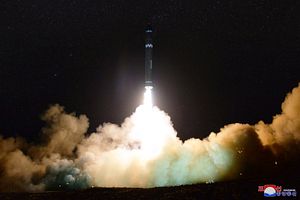In the middle of the night on November 29, North Korea launched its largest ballistic missile to date, the Hwasong-15.
The event ended a more than two-month pause in the country’s missile testing and showed that contrary to some assessments, Pyongyang’s ballistic missile ambitions remained in tact and that it had never intended to stop after perfecting the Hwasong-14 intercontinental ballistic missile (ICBM) it demonstrated in the summer.
The Hwasong-15, North Korea’s newest and greatest ICBM, is a monster of a missile. During the November test, it flew to an altitude of 4,500km, higher than any missile previously tested by the country.
(They purposely fired it at a steep angle to prevent it flying over Japan and keep its components within range of their land-based sensors to gather data.)
Experts said that had North Korea chosen to fire the missile at a more normal trajectory it would have been capable of flying up to 13,000km, putting the entire US mainland within range. That’s a significant improvement on the Hwasong-14, which could reach only parts of the US mainland, depending on its payload.
Taken together with North Korea’s September test of a claimed thermonuclear bomb, the Hwasong-15 is a concerning development. This missile is designed to deliver precisely that kind of weapon to targets on the eastern coast of the United States, including Washington and New York.
However new and impressive the Hwasong-15 might be, it changes little as far as the US and North Korea’s regional neighbors are concerned. Instead, it serves as a reminder of the urgency of the threat, which assumed a new character this year after Pyongyang introduced a wide range of strategically significant missile systems even beyond its two new ICBMs.
For the United States, little has changed since the Trump administration first articulated its policy of “maximum pressure” and declared the Obama administration’s much-maligned policy of strategic patience over.
With two new UN Security Council sanctions resolutions passed this year, following North Korea’s first ICBM tests and its thermonuclear bomb test, Washington has seen some success with this policy.
The Trump administration has won Chinese acquiescence on new sanctions and partially conditioned Beijing to take action against financial institutions under its jurisdiction that fund North Korea’s ballistic missile and nuclear programs, with the threat of expanded secondary sanctions still looming large.
But even as sanctions bear down on the regime, there’s little evidence that they will be able to function in the manner envisaged by their proponents. North Korean Supreme Leader Kim Jong-un’s cost-benefit calculation appears to be immutable as he sees nuclear weapons as the ultimate guarantor of security against regime change. No matter what the cost of sanctions, North Korea will retain its nuclear force.
In the meantime, the Trump administration continues to reinforce Kim’s thinking by cryptically threatening military action and implying that time is running out for the United States to act. Trump’s National Security Adviser H.R. McMaster, following the Hwasong-15’s launch, said that the possibility of war was “increasing every day”.
It remains an open question if US officials are making the risk of war appear uncomfortably high to gain credibility against Kim or condition China to enforce sanctions, but this approach is ultimately dangerous – especially as the US and South Korea continue to carry out high-stakes military exercises involving stealth aircraft and heavy bombers that could lead to a devastating miscalculation on Kim’s part.
For China, the administration’s mixed messages only reinforce a view that the United States is not interested in a good faith pursuit of non-military options to denuclearize the Korean Peninsula. Beijing has recalibrated its approach this year, favoring a so-called freeze-for-freeze agreement that would see North Korea agree to a halt in missile and nuclear testing in exchange for a rollback in US-South Korea military exercises.
Ultimately, what is needed is for the United States to unequivocally state that it prefers diplomatic engagement with North Korea over a completely avoidable military conflict. Certain officials, notably US Defence Secretary Jim Mattis, have done this, but to be credible it must come from Trump.
Such an assurance would not only lower the temperature with Pyongyang, but could sway China to play its part and better enforce sanctions. The Trump administration can retain its leverage over Beijing by maintaining the threat of expanded secondary sanctions, too.
North Korea’s decision making is likely to remain unchanged in the meantime and it will continue to push ahead with its nuclear force.
Kim was quoted by North Korean state media as saying that the Hwasong-15 represented the completion of the country’s historic quest for a credible nuclear deterrent against the United States, but that doesn’t mean the country’s tests will end.
A version of this article first appeared in the South China Morning Post. It is republished here with kind permission.

































